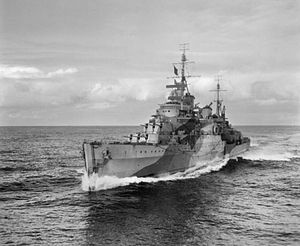Town-class cruiser (1936)

HMS Liverpool in 1942
|
|
| Class overview | |
|---|---|
| Name: | Town class |
| Operators: |
|
| Preceded by: | Arethusa class |
| Succeeded by: | Dido class |
| Subclasses: |
|
| Completed: | 10 |
| Lost: | 4 |
| Retired: | 5 |
| Preserved: | 1 |
| General characteristics | |
| Class and type: | Light cruiser |
| Displacement: |
|
| Length: |
|
| Beam: |
|
| Draught: |
|
| Installed power: |
|
| Propulsion: |
|
| Speed: | |
| Range: | 5,300 nmi (6,100 mi; 9,800 km) at 13 kn (15 mph; 24 km/h) |
| Capacity: | 1,325 short tons (1,202 t) fuel oil |
| Complement: | 750 |
| Sensors and processing systems: |
Radar |
| Armament: |
|
| Aircraft carried: | 2 × Supermarine Walrus flying boats (removed in the latter part of WWII) |
| Aviation facilities: | 1 × catapult |
The Town class was a 10-ship class of light cruisers of the Royal Navy. The Towns were designed to the constraints imposed by the London Naval Treaty of 1930. The ships were built in three distinct sub-classes, the Southampton, Gloucester and Edinburgh classes respectively, each sub-class adding on further weaponry.
Like their US and Japanese counterparts of that era, the Town-class cruisers were "light cruisers" in the strict terms of the Treaty. The London Treaty defined a "light cruiser" as one having a main armament no greater than 6.1 in (155 mm) calibre, all three major naval powers sought to circumvent the limitations on heavy cruiser numbers by building "light cruisers" that were equal in size and effective power to heavy cruisers. These ships made up for their smaller calibre guns by carrying larger numbers of them.
All of these ships carried BL 6-inch Mk XXIII guns in triple turrets, with the centre gun mounted 30 in (76 cm) behind the two outer guns to prevent interference between the shells in flight and to give the gunners more room to work in. The turret roofs had cutouts at the front to allow extreme elevation, originally intended to give the guns an anti-aircraft capability. In practice the guns could not be trained or manually loaded quickly enough for continuous anti-aircraft fire, so the Royal Navy designed the ABU, which allowed the guns to be preloaded with time-fuzed shells and then fired when the target aircraft reached the preset range. These ships were equipped with the HACS AA fire control system for the secondary armament and the Admiralty Fire Control Table for surface fire control of the main armament.
The secondary armament consisted of four twin XIX 4-inch turrets, and two quad pom poms. Additional light antiaircraft weapons were added during the war and the 4-inch mounts were converted to RPC. Postwar the Birmingham and Newcastle were partially reconstructed in 1949-51 with enclosed bridges, new lattice masts, improved surface fire control and long range radar, and an improved but still unreliable version of the Glasshouse Directors with 275 lock and follow radar, with flyplane control for the twin 4 inch guns with elevation speed increased to 15-20 degrees per second to engage faster jet aircraft. Similar electronic alterations were made to Sheffield, but it received less structural alteration. Liverpool was put into reserve in 1952 to preserve it for potential modernisation and Glasgow had a less extensive refit to allow her to be sent quickly if needed in the Suez crisis of 1956. Birmingham, Newcastle and Sheffield had the pom pom and 20 mm armament replaced by 40mm Bofors mounts. Belfast was fitted with MRS 8 HACDT to combine 40mm and twin 4 inch AA fire and to permit the use of 40mm proximity fused ammunition as used by the British Army.
...
Wikipedia
